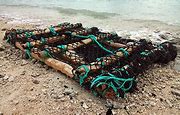Drifting Fish Aggregating Devices (dFADs), those floating rafts with underwater netting that fishing vessels use to attract tuna, have become a significant concern for marine ecosystems worldwide. A recent study found that between 2007 and 2021, a staggering 1.41 million dFADs floated through approximately 37% of the world’s oceans, ending up in 104 maritime jurisdictions. The consequences were dire, with these devices frequently polluting sensitive marine habitats and causing severe ecosystem damage.
The Indian and Pacific oceans bore the brunt of these strandings, with countries like Seychelles, Somalia, and French Polynesia accounting for a significant portion of the cases. The impact cascades onto local communities who are left grappling with the aftermath – from habitat loss to bearing the hefty cleanup costs. As Boris Worm, a marine ecologist at Dalhousie University explained,
“Stranded dFADs can cause local habitat loss and pollution… Cleaning up stranded dFADs can be very costly.”
These floating devices play a crucial role in modern tuna fishing practices by enabling purse seiners to capture skipjack, yellowfin, and bigeye tuna more efficiently. However, their widespread usage has raised concerns about their environmental repercussions. While some argue that dFADs aid in precision catching of tuna and support scientific research efforts while adhering to fishing regulations set by regional fisheries management organizations (RFMOs), others emphasize their detrimental effects on ocean life.
According to Glen Holmes from Pew Charitable Trusts, understanding the impact of three decades of dFAD fishing is crucial as it sheds light on regulatory loopholes within RFMO regulations and MSC certification processes. Despite efforts to regulate dFAD deployment through measures like capping active devices per vessel since 2017, concrete actions remain limited.
The study also highlights how dFAD use has altered tuna behavior patterns by increasing juvenile catches which could jeopardize long-term stock sustainability. Additionally, there are growing concerns that dFAD strandings pose a threat to biodiversity hotspots and marine protected areas worldwide.
Efforts to address these challenges include advocating for stricter deployment limits globally along with implementing full observer coverage across all RFMOs. Creating regional registries for dFADS could enhance accountability measures as researchers push for clearer ownership rules regarding these drifting devices.
In conclusion, while drifting fish aggregating devices serve an instrumental role in the global tuna industry, it is imperative to strike a balance between economic interests and environmental conservation. By addressing existing regulatory gaps alongside promoting sustainable fishing practices globally, we can strive towards safeguarding our oceans’ delicate ecosystems for future generations.

